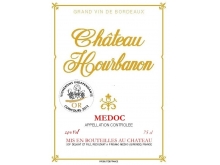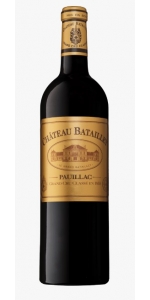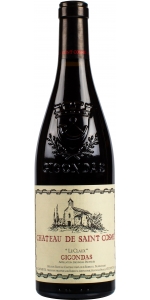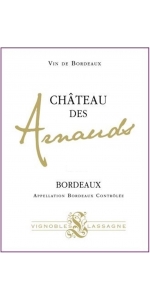Chateau Hourbanon Medoc 2010
| Country: | France |
| Region: | Bordeaux |
| Winery: | Chateau Hourbanon |
| Grape Type: | Cabernet Sauvignon |
| Organic: | Yes |
| Vintage: | 2010 |
| Bottle Size: | 750 ml |
Chateau Batailley Grand Cru is made from 78% Cabernet Sauvignon, 19% Merlot, 2% Petit Verdot & 1% Cabernet Franc.
Château Batailley is a winery in the Pauillac appellation of the Bordeaux region of France. The wine produced at the estate was classified as one of eighteen Cinquièmes Crus (Fifth Growths) in the Bordeaux Wine Official Classification of 1855.
Garnet-purple colour. Rich and expressive nose, fruity with notes of spices, smoke and vanilla. On the palate, this wine is supple, round, well balanced, with good acidity, a nice fruitiness and nice notes of leather and cedar. Long elegant finish.
Review:
The 2010 Batailley repeated its magnificent showing when poured at the chateau. It has a detailed bouquet of blackberry and cedar, quite backward and seemingly having advanced lite since | tasted in in April 2016. The palate remains full of tension and brimming with energy, delivering classic cedar and tobacco notes toward the persistent finish. Batailley can produce wines that live many decades, and this is clearly one of them. Tasted at the property. Drink 2020-2050
- Neal Martin Vinous 95 Points
All older vintage wines have been purchased from a single collectors cellar. Pictures can be requested before shipment.
All older vintage wines have been purchased from a single collectors cellar. Pictures can be requested before shipment.
Chateau de Saint Cosme Gigondas Le Claux is made from 95% Grenache, 5% Syrah.
Château de Saint Cosme is the leading estate of Gigondas and produces the benchmark wines of the appellation. The property has been in the hands of the Barruol family since 1490. Louis Barruol took over from his father in 1992 making a dramatic shift to quality and converting to biodynamics in 2010.
Château de Saint Cosme Gigondas Le Claux is the estate’s oldest vineyard and sits near the entrance to the winery. “It was first planted in 1870 following phylloxera. My uncles thought it wasn’t producing enough fruit and planned to uproot it in 1914,” says Louis Barruol, but “World War I interrupted that plan.”
The 1.8-hectare Le Claux—meaning “Clos” in old French—is a field blend of predominately Grenache. Louis Barruol believes 10% of the vineyard is from the original 1870 planting. Vines are replaced by massal selection and the average vine age is 60-years. The wine is made with whole cluster fermentation from indigenous yeasts, is aged in 20% new 228-liter barrels, and bottled without fining or filtration.
Tasting Notes
Brilliant violet color. Displays pungent, mineral- and spice-accented cherry, black raspberry, potpourri and licorice aromas, along with hints of savory herbs, vanillo and incense. Chewy and tightly focused on the palate, offering bitter cherry, dark berry and Moroccan spice flavors that unfurl slowly through the back half. It closes with firm tension, chewy tannins and excellent tenacity, leaving resonating cherry and floral notes behind. All barriques, a third of them new.
-Vinous 95-97 Points
All older vintage wines have been purchased from a single collectors cellar. Pictures can be requested before shipment.
Chateau Arnauds des Bordeaux Rouge is made from 100% Merlot.
The wine shows a deep red purple color and intense aromas of black fruits (blackcurrant, black cherry) with hints of liquorice. Very fruity and well-balanced. It is powerful and well structured in the mouth with round and silky tannins, ripe flavors of black fruits. Strong and a slightly spicy finish.
Grapes are coming from 30 year old vines planted on gravelly soils.
The land benefits from sun exposure, warmth and humidity that are strong assets for the vine culture.
The wine pairs well with game meat and beef on the grill.
Appellation: Medoc
Chateau Hourbanon Medoc is made from 65% Cabernet Sauvignon, 30% Merlot, 5% Cabernet Franc
Aging: Aged 1 year on French oak
Tasting Notes: Straight attack in the mouth with supple, silky and harmonious tannins.
Very mature, Almost jammy fruits aromas with a touch of spicy notes.
Avg Age of Vines: 38 years
Review:
This densely textured wine is ripe with blackberry fruits over firm, smoky tannins. It has a generous feel to it, rich with fruitiness while just moving into a more mature mode. Drink this wine now for its forward fruit, although it will be even better from 2017. WE 90 Points
Chateau Hourbanon Estate
The vineyard Hourbanon appears in the 6th edition of Bordeaux and Its Wines, Editions Feret (the bible of Bordeaux wines), classified under the headings of Crus Artisans and Farmers in 1893. At that time the vineyard belonged to the Drouillet family, one member of whom was mayor of Lesparre.
In 1898, according to the 7th edition of Bordeaux and Its Wines, the vineyard became Cru Bourgeois, still belonging to the same family and producing 35 tons, or 31,500 liter, equivalent to 42,000 bottles
At that time, the operation is called Cru-Hourbanon, since at that time the Chateau La Cardonne was a neighbor located on the same road, 1km away. Unfortunately, the hardships of operating in the decades that followed is not known. It seems that the vineyard has had ups and downs with the same period of abandonment.
After their return from Algeria, the Montgaillard family acquired the vineyard. The Family Montgaillard operated this small area shared between the vineyards and some cows. They sold grapes to the cooperative, and the brand at that time fell into disuse somewhat.
In 1974 Rémi Delayat, the current owner’s father, acquired this vineyard. It was in pretty bad shape. This dentist from Yvelines, originally from Bresse and passionate about wine decided to restore the credentials in the vineyard of Hourbanon. Remi constructed a modern winery, and rehabilitated the old wine cellar for storing and aging wine bottles. He also renovated the farmhouse. All of this renovation work lasted several years, which his wife Nicole Delayat continued after the premature death of Remi in 1981.
Hugues, their son, took over in 1997. Having bathed in the passion of wine since childhood, he faces this trade directly in contrast to his parents. But certain constants have transcended generations : a passion for wine, respect for the land, and taste for wines of the Médoc.
- back
Checkerboard Kings Row Red is made from Cabernet Sauvignon, Merlot, Petit Verdot.
2019 Checkerboard Kings Row is produced from grapes grown in the Aurora Vineyard which is located in a small valley midway up Diamond Mountain on a large knoll at an elevation of 1,200 feet. The knoll projects off the mountainside, giving the vineyard full southern exposure, open light from the east and west, and protection from Napa Valley’s summer fog. Six acres are planted in the knoll’s rich, volcanic soils that are riddled with basalt cobble and loamy clay. The remaining six acres are planted in a deep gravely mix of white volcanic ash and chips of decomposed Rhyolite that were washed down from the steep, rocky crags of Diamond Mountain above. 2019 Checkerboard Kings Row is a complex wine showcasing the Bordeaux varietals grown in the Aurora Vineyard. The nose is a swirl of dark red fruits, baking spice, and sandalwood. On the palate, the fruit dominates and offers hints of dried crushed herbs, black pepper, and freshly pressed espresso. There’s a juicy core which is persistent from the approach through to the finish.
Salvadori Chianti Riserva DOCG 2017 is made from Sangiovese 90% , Merlot 10










